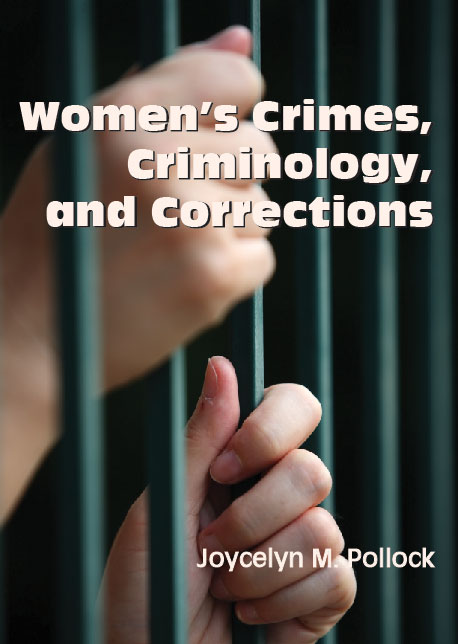
397 pages, $52.95 list
1-4786-1150-2
978-1-4786-1150-9
© 2014
paperback
Instructor's Manual available
eBook availability
Women's Crimes, Criminology, and Corrections
Historically, women have been an afterthought in criminal justice policymaking and the criminological enterprise. The study of criminology has largely been the study of criminal men, because women commit less crime than men. More recently, criminologists have paid increased attention to the population of female offenders, partly because of their growing numbers and partly because of the tens of thousands of children affected by having their mothers in prison or on supervised release. The recent attention, however, has not necessarily been a good thing for women, who are much more likely to be formally prosecuted and incarcerated today than in decades past. This policy shift has come about partly because of misinformed policies implemented to “help” women, and partly because of shifts in theorists’ beliefs and public perceptions that women and men are similar in their criminal motivations and should, therefore, be treated similarly. The controversy surrounding this perception is the focus of this book.
To better comprehend the challenges facing women in the criminal justice system, the author (a winner of the Bruce Smith Sr. Award from the Academy of Criminal Justice Sciences) employs research findings and statistics to: describe the prevalence and patterns of women’s crimes; review criminological theories, specifically examining how well they explain female criminality; understand female juvenile offenders, reviewing crime rates, theories relating to female delinquency, and detention-related issues; look inside the women’s prison to better understand female prisoners and their world; examine classification and programming issues—particularly the impact of gender-specific programming; and explore the problems experienced by women upon release and the related issue of women’s recidivism.
To better comprehend the challenges facing women in the criminal justice system, the author (a winner of the Bruce Smith Sr. Award from the Academy of Criminal Justice Sciences) employs research findings and statistics to: describe the prevalence and patterns of women’s crimes; review criminological theories, specifically examining how well they explain female criminality; understand female juvenile offenders, reviewing crime rates, theories relating to female delinquency, and detention-related issues; look inside the women’s prison to better understand female prisoners and their world; examine classification and programming issues—particularly the impact of gender-specific programming; and explore the problems experienced by women upon release and the related issue of women’s recidivism.
Reactions
“An excellent overview of this generally invisible subsection of the criminal justice system.” — Barbara Baumgartner, Washington University
1. Introduction: Framing the Questions
Criminology and Positivism / Measuring Crime and Crime Correlates / Feminist Criminology / Sexual Stereotypes and Sex Differences / Framing the Questions: The Criminology of Women
2. Women's Crimes
The Gender Gap / Explanations for Convergence / Property Crimes / Violent Crimes / Drug Crimes / Other Crimes / Race and Crime / Conclusion
3. Traditional Theories: 1800s–1970s
Theoretical Concerns / Classical Theory (1700s) / Positivism (1800s) / The Chicago School (early 1900s) / Social Control Theory / Labeling and Conflict Theories / Psychological Theories of Crime / Early Feminist Theories of Crime / Conclusion
4. Current Theories of Crime
The General Theory of Crime / General Strain Theory / Rational Choice Theory / Social Support Theories / Sex-Role and Feminist Theories Revisited / Biological Theories of Crime / Conclusion
5. Life-Course and Pathways Theories
Life-Course and Integrated Theories / Pathways Research / Making Sense of Theoretical Findings / Conclusion
6. Juvenile Offenders
Female Delinquency / Delinquency Theories / Juvenile Justice System / Conclusion
7. Chivalry, Sentencing, and Jails
Disparate Sentencing Laws / The Chivalry Hypothesis / Sentenced to Prison / Sentenced to Death / Jails and Jail Inmates / Conclusion
8. Women's Prisons
Women's Prisons / The History of Women's Prisons / Female Prisoners / Management Issues in a Women's Prison / Conclusion
9. The Prison World
Entering the Prison / The Prison World / Prisoner Subculture / Violence / Correctional Officers / Conclusion
10. Classification and Programming
Classification and Prediction / Programming in Prison / Gender-Responsive Programming / Drug-Treatment Programming / Incest Survivor Programming / Parenting Programming / Conclusion
11. Release, Recidivism, and Recommendations for the Future
Parole / Recidivism / Evaluation of Treatment Programs / Policy Recommendations
Glossary
Criminology and Positivism / Measuring Crime and Crime Correlates / Feminist Criminology / Sexual Stereotypes and Sex Differences / Framing the Questions: The Criminology of Women
2. Women's Crimes
The Gender Gap / Explanations for Convergence / Property Crimes / Violent Crimes / Drug Crimes / Other Crimes / Race and Crime / Conclusion
3. Traditional Theories: 1800s–1970s
Theoretical Concerns / Classical Theory (1700s) / Positivism (1800s) / The Chicago School (early 1900s) / Social Control Theory / Labeling and Conflict Theories / Psychological Theories of Crime / Early Feminist Theories of Crime / Conclusion
4. Current Theories of Crime
The General Theory of Crime / General Strain Theory / Rational Choice Theory / Social Support Theories / Sex-Role and Feminist Theories Revisited / Biological Theories of Crime / Conclusion
5. Life-Course and Pathways Theories
Life-Course and Integrated Theories / Pathways Research / Making Sense of Theoretical Findings / Conclusion
6. Juvenile Offenders
Female Delinquency / Delinquency Theories / Juvenile Justice System / Conclusion
7. Chivalry, Sentencing, and Jails
Disparate Sentencing Laws / The Chivalry Hypothesis / Sentenced to Prison / Sentenced to Death / Jails and Jail Inmates / Conclusion
8. Women's Prisons
Women's Prisons / The History of Women's Prisons / Female Prisoners / Management Issues in a Women's Prison / Conclusion
9. The Prison World
Entering the Prison / The Prison World / Prisoner Subculture / Violence / Correctional Officers / Conclusion
10. Classification and Programming
Classification and Prediction / Programming in Prison / Gender-Responsive Programming / Drug-Treatment Programming / Incest Survivor Programming / Parenting Programming / Conclusion
11. Release, Recidivism, and Recommendations for the Future
Parole / Recidivism / Evaluation of Treatment Programs / Policy Recommendations
Glossary